#dark souls lore
Text
dark souls lore: velka, goddess of sin, and that stupid plot against the stupid gods (5k words)
*written to entertain both hardcore fans and fandom rubberneckers
i made the mistake of thinking about dark souls lore the other day after choosing to make myself mad about the remaster again, but in the worst possible way. soulsborne fans know to fear and run from anyone who starts talking about this unseen character known only through item descriptions: velka, goddess of sin. if you start talking about velka you’re too far gone in the souls sauce and about to spout some of the most unhinged nonsense ever uttered by a human on the entire history of the planet. velka and the highly secretive “plot against the gods” are quietly mentioned in less than 10 item descriptions. no character utters her name or speaks of the rebellion she participated in, she and her comrades do not appear in the game…probably. its complicated.
her inclusion initially reads as a throw-away means of world-building; much like the now infamous line about the “clone wars” in “star wars: a new hope” that was needlessly fleshed out into a trilogy that haunts us even to this day, the item descriptions serve to establish that you have entered a world overflowing with heroes and history that you were not privy to nor took part in. these events are such a basic foundation of lordran history that no one mentions it because it would be inorganic and narratively heavy-handed. its like if we walked around talking about when lincoln was shot on a day to day basis just in case anyone wasn’t up to speed.
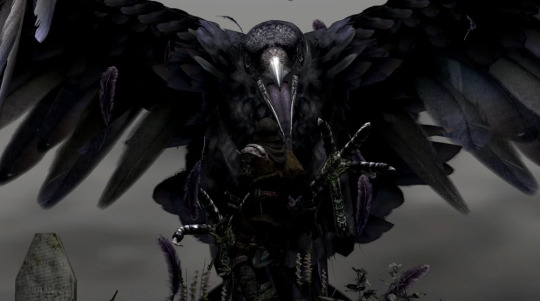
anyway, this thought process started after i realized how fucking weird it is that a giant crow transports you from undead asylum to firelink shrine…why would it do that??? like, yes, obviously it’s a gameplay contrivance in order to get you from point A to point B with a cinematic, fantastical flair, i understand that. i also understand that velka herself is a gameplay contrivance with story written around it to soften the landing, but unfortunately, dark souls is a thread that unravels quickly when you pick at it, revealing shocking narrative cohesion underneath. if you’re completely insane, that is.
we will do this in a journalistic manner: who, what, when, where, why. but first, it requires a lot of dark souls history/lore context. it’s a lot. stick with me.
---
(READ MORE)
this is so much info. this also contains gay dragon theory and somehow argues that it's supported by text. why not. please enjoy this unbelievable amount of words regarding a non-entity who does not exist meaningfully in any of the three games.
190 notes
·
View notes
Text
The Souls Lore Community: Someone Should Be Studying This.
As I was watching SmoughTown's most recent Elden Ring lore video, I started thinking about the lore hunting of Souls games as a social phenomenon, and I genuinely hope this community is studied by psychologists and social scientists someday, because it's worthy of research.
Normally the rise of FromSoftware's games from relative obscurity to worldwide fame is what people might be interested in, but the dedicated lore community online and especially on YouTube is especially fascinating to me. Dozens of YouTube channels are specifically dedicated to collecting, compiling and deciphering every scrap of lore and storytelling available in these games with a deliberately obfuscated storyline, and hundreds of thousands of people watch and consume this content, not simply satisfied with playing the game, but joining in on the search, the debate and discovery.
I'm reminded of Jacob Geller's absolutely stellar video "Shadow of the Colossus and the Search for the Last Great Secret", and I feel like the modern Souls lore community is a convergently evolved social phenomenon to the "Secret Seekers" on those old forums trying to tease out the last secrets of Fumito Ueda's masterpiece (Hidetaka Miyazaki was directly influenced by Ueda's work, so this makes sense).
People will evaluate Souls lore with greater skepticism than I see most people use for their political or personal beliefs, and the lore debates I've seen in person often feel like academic discourse more than your average nerds discussing their favorite game, so I suppose all I have left to say is "why is no one studying this???"

#elden ring#elden ring dlc#elden ring lore#dark souls#dark souls lore#demon souls#demon souls lore#bloodborne#bloodborne lore#soulsborne#souls lore#video games#fromsoftware#fromsoftware games
147 notes
·
View notes
Text
The Soul Still Burns: Analysis of the Lords of Cinder (DS3)
What follows is a short essay on the Lords of Cinder from Dark Souls 3, exploring their symbolism on spiritual and metatextual levels. After that is a related reading of Slave Knight Gael, the final adversary of the Dark Souls trilogy.
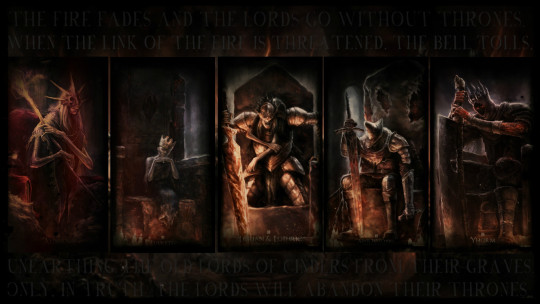
The Lords of Cinder are in many ways the primary adversaries of Dark Souls 3. This title they share, “Lord of Cinder,” refers to a personage who has rekindled the first flame, keeping the cycle of light and dark going.
Cinder is a substance which continues to burn without the presence of fire but does not reduce to ash. So euphemistically, it seems that the Lords are somehow stuck in their process of purification, and the game suggests that the world is stuck along with them; this is why it is the Ashen One’s task to “set them upon their thrones”—to hurry them along and thus allow the world to follow its natural decline. As individual characters, each of these Lords represents a different attitude that complicates and prolongs the cycle.
Through these stubborn Lords the game is commenting on at least two things. On the metaphysical level, it reflects the Buddhist idea that certain attitudes keep people reincarnating over and over again, unable to extricate themselves from the material world of suffering (samsara). While on the metatextual level, the game is suggesting that certain attitudes keep players coming back to Dark Souls again and again, starting new games, making new builds and revisiting old files.
The idea there on the metaphysical side finds an easy analogy in Buddhist doctrine: the “three poisons,” the three root causes of suffering. These are hatred, greed, and delusion. What’s interesting is that these essential vices also fit pretty easily onto the different types of players that are being caricatured by the Lords. We’ll break these correspondences down in a second.
But First: Why Do They Correspond?
So we have these sets of three. Three lords, three poisons in Buddhism, three types of Souls players. How convenient. When we analyze art, we sometimes ask, “Huh, is this structure really there, or am I projecting it into the material?” And if the structure is really there, baked into the work, that doesn’t mean that it’s due to developer intention. Archetypal forms sometimes show up in work via an unconscious influence, be it due to the cultural milieu, personal psychology, or some a priori biological disposition of the human being.
And the thing about Dark Souls is that it’s an unusually honest piece of art, in that its creative team allows their own free associations and intuitions to show up in the work without too much self-censorship or questioning. They make space for a mystery to show up on its own terms, and in leaving its riddles unanswered, there is more space for discovery by the people who play it.
It should also be said that cultural ideas persist for a reason. Beneath the ethics and ideology of the people who originally named the Buddhist “three poisons,” there may be something timeless, something perennially descriptive of human nature. If that is the case, then it would make sense for this same triplicity to unfurl itself in other cultural products. So for one reason or another, these three poisons, these addictions, show up diegetically in the characters and are also expressed in player psychology.
I say all this just because sometimes I feel very aware of the disconnect between much of Souls lore discourse and the broader field of mythological study. Since we are gamers first, there may be this tendency to want to “solve” the lore, but that’s not what we’re doing here. Myth functions because it elaborates our experience of the world through affective resonance; it attaches images and characters and stories which help us anchor our own prelinguistic impressions of the world, cultivating our sensitivity there.
Anyway, let’s look at these Lords.
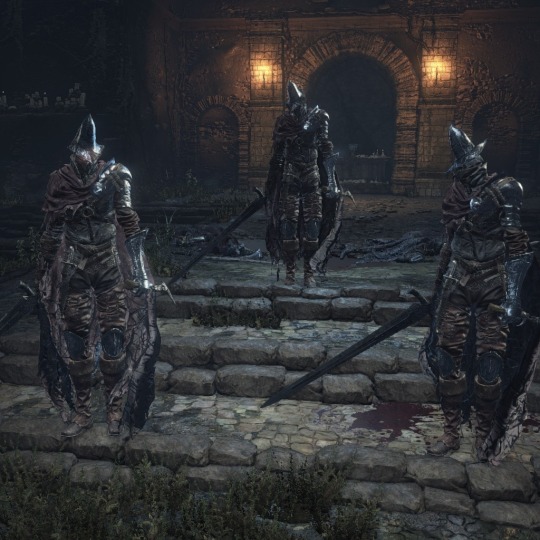
Abyss Watchers
Poison: Hatred
The lore of the Abyss Watchers is pretty clear: they have an obsessive fixation on the abyss, and are ready to raze an entire town if they suspect abyssal encroachment. This obsession has literally possessed them, as they are now “abyss touched.” Gaze too much into the abyss, etc. They carry such strong contempt for the disavowed object that they don’t care what comes between it and their sword. This is clearly demonstrated by the fact that they are a brotherhood yet are unhesitatingly slaughtering themselves again and again. Hatred has made them blind, and has also caused them to resign their individuality (they are identical, mere instruments of a transpersonal grudge). They cannot die, their hatred keeps them locked in combat.
Type of Player: competitive | Interest: combat
The Abyss Watchers are a representation of PvP addicts. They have no powers other than tenacity; they perform the same combos repeatedly. When you are really gripped by a PvP binge in Souls, you often end up doing the same thing again and again. The fight takes place in a mausoleum, on top of many chambers filled with human remains. The fact that this boss fight is instructional about combat, specifically about looking for tells (a cloud of dust always signifies the end of their combos) might be another clue. There is no limit to how good you get at Souls PvP; every foe is an opportunity to improve timing and strategy. You can just keep stacking anonymous bodies under yourself.
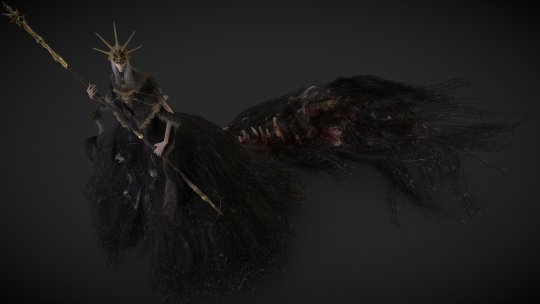
Aldrich
Poison: Greed
Aldrich invokes the concept of supremacy many times: he is in the supreme area from Dark Souls 1; in the supreme boss room of that area; he wears as a crown the former supreme lord of that area. This is because he devours lords; he tries to take prestige upon himself through acquisition and incorporation—greed.
Type of Player: completionist | Interest: content
Aldrich is a commentary on completionist players. He is someone who “plays the game to death”, acquiring every object, reaching every achievement, devouring the soul of the game through taking everything into himself. He becomes bloated by consuming as much of the game’s content as possible. The old God whose likeness he has adopted is Gwyndolin, who was, in narrative terms, the one pulling the strings in the land of the Gods. And in gameplay terms, he is a secret boss. So on both counts we have someone who is elusive, and exists more or less at the boundary of the gameworld. When a player tries to see every last little morsel of a game, they become somewhat like Gwyndolin, a manipulator of a virtual world. If you know too much about a game, you have the risk of being less immmersed.
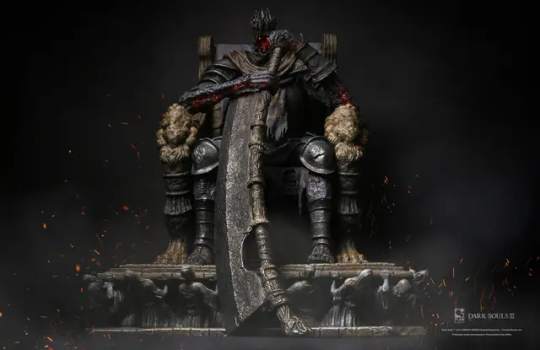
Yhorm
Posion: Delusion
In Buddhism, the poison of delusion secretly underlies the other two poisons, as the impulse toward hatred and greed are ultimately born of some false view about reality. This is akin to how the profaned capital sits below the rest of the kingdoms. To beat Yhorm you essentially have to “play pretend” with him, picking up a fake super-weapon, or fighting alongside Siegward, a knight who appears to be somewhat deluded about the state of the world, enthralled in the same fantasy as Yhorm himself.
Type of Player: lore researcher | Interest: meaning
The profaned capital is full of statues—fixed images of myth; and empty goblets—treasures with no utility. Not to mention the area with the swamp which is full of symbolic imagery, but serves no narrative or mechanical purpose. The entire profaned capital challenges us to make sense of it; it is the ultimate temptation of lorekeepers in DS3. It throws at us a disproportionate amount of reference to DS2, which is famous among Souls players as the least thematically sensible Souls game. The Greatshield of Glory is found right outside Yhorm’s room, in a conspicuous room full of treasure, and yet it is a very impractical shield and offers very little lore value. If a lore-minded player picks it up, it directs them to a legendary personage from the War of Giants, which raises far more questions than it answers. The same is true of much of this area—the Eleanora, the Monstrosities, the Profaned Flame itself—they are all there to get you to speculate. These are the players who come to Souls games again and again, trying to find the “ultimate meaning.” They seek the grail, claim to find it, and then chuck in a pile with the others.
Yhorm's story also imitates the primordial Artorias myth: forsaking his shield in preservation of something more valuable. Other than that Yhorm is largely a cipher when it comes to biography, with a void for a face, which itself epitomizes what must remain at the center of mythology and storytelling: mystery.
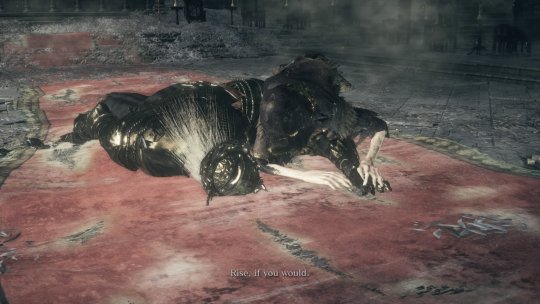
Sit Down and Seek Guidance
So we have the three reasons that people become fixated on Souls: the combat, the achievements, and the mystery. But there is a fourth lord of cinder boss, who is conceptually apart from these three: the Lothric Twins. They represent yet another kind of person who must keep playing Dark Souls: the developers. Lothric is striving to produce “a worthy heir,” a proper sequel to Dark Souls 1. The Princes are bound to their chamber as the developers are bound to their project, as that is their curse—“but you may rest here too, if you like.” In this context we can see their duality as the dual nature of having to work on the game and also play it to death. The privilege and the loftiness of the promise of a great piece of art (Lothric), and also having to go back "into the trenches" of the work itself (Lorian). Notably, neither of them can walk, they just teleport around. They are stuck at work, trying to bring the new world into being. Also I can’t go this whole essay without mentioning the obvious: that the Ashen One is bringing Lords to their thrones, and we players and developers have to assume our little chairs and couches when we access this world.
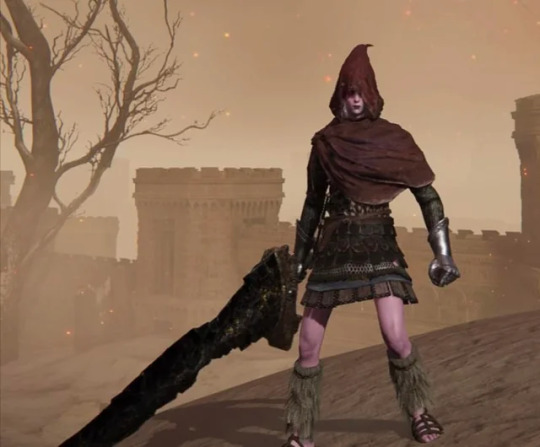
Playing Beyond the Point of Pleasure
Of course the most extreme example of someone stubbornly remaining in the world no matter what is Slave Knight Gael. He is looking for pigment, which seems to be a euphemism for the substance of humanity (the Dark Soul). He wants to give it to the painter, the world-creator, so that a new world can be made. He is willing to indulge in a wasteland of abject violence for as long as it takes in order to renew something. Ironic that he is probably only prolonging the current world in his obsessive drive to recycle it faster.
Let’s examine the relationship between the figure of the painter and her relationship to Gael. That she is a spiritual entity is obvious: we never see her touch the ground, she is always in an upper room and lifted on a piece of furniture. Among other things, she is a clear metaphor for life springing eternally. A creative child who continues to paint despite kidnapping and imprisonment. She is the heart of the painted world, itself a place that symbolizes the idea of the representation of reality.
I want to make sure this is clear, because it is a bit of a kaleidoscope to consider. Any subject in Dark Souls stands for many things, but something that the painted world specifically represents is the very concept of representation. So of course the places in our imaginations are painted worlds, but so is this physical world of appearance, the maya of mundane reality. Not to mention that a work of art is a painted world, and the game we’re discussing is a painted world. When a work of art is able to recreate itself in itself, we can see this funny effect of mirrors reflecting mirrors infinitely. This results in seemingly inexhaustible symbolic content—there is so much potential to find meaning and create connections. Because Moby Dick represents a work of literature; the Tempest represents a play; Twin Peaks represents a TV show, these works can offer extensive insights not only into their medium but into the nature of reality. In these and other examples, the representation of the medium within the work may or may not be a single subject, but since Dark Souls is formally a game about levels and level design, the painted world is the heart of its self-reflexivity. The painted world can be pointed to as the summary of this fractal device. And the personification of that device, its ambassador to the player, is the painter.
The miracle or divine child is also an archetype familiar to us from Lothric, in their struggle to produce the “worthy heir.” Reality seeks salvation through the appearance of grace. They want it in a clear, incontestable form—to be able to point at it and say, "thank goodness we went through all that, because look, now here is the meaning, here is that which validates all that came before." In the world of Dark Souls 3 the religion of the masses is the Lothric stuff; meanwhile knowledge of the painted world is much more obscure. Lothric’s religion is obviously regulated and hierarchical, while Gael’s devotion to the painter is highly personal and private: he carries around a scrap of painting; he prostrates to a hidden idol in a small chapel; he considers the painter his family. He is emotionally close to the object of his worship.
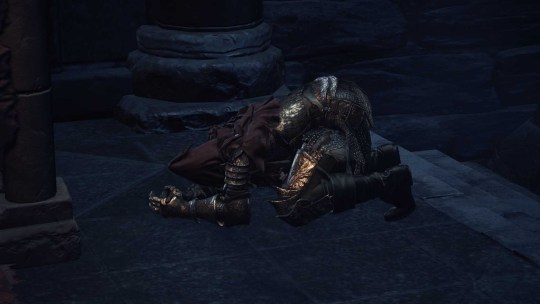
But whether it’s Lothric or Ariandel, they are anticipating the divine child to redeem the world. As an archetype, the child ultimately represents surprise. The possibility of being delighted by life in its creative novelty. The child as an archetype appears in our own behavior when we do something without any sort of contrivance or mental interference, doing something in the world which doesn’t seem to have come from who we conceive ourselves to be. This is miraculous. Such an action enchants the world, and there is no explaining it, even if it may weave all kinds of stories around itself, retroactively framing things that have led up to it as portents or promises. (Though not exclusive to him, this trait is well-known in characterizations of Christ, and DS3 is clearly indebted to Christian iconography, so do with that what you will). Regardless of the specific cultural invocation, the divine child is a personification of something that happens within the human spirit. TFW you are renewed by a fresh and spontaneous engagement with life.
The grace of the miraculous often comes to us through play. Play is more of an attitude than an activity; the feeling of play may come to us through making a painting, or chatting with a friend, or moving around in a video game. We can play video games idly, competitively, experimentally, creatively, studiously, whatever, the feeling of “play” can show up regardless. We can sit there playing a certain game from a certain motivation, and feel totally rote and joyless, and question, “Why am I doing this?” Or we might sit there and play the same game with the same motivation, feeling totally lit up by it, its purpose to us obvious and self-validating. We are not even questioning why we are doing it, we are enjoying life.
This is really the ground that the miraculous tends to land on. Grace, meaning, and an immanent love of life are more likely to show up when we are in flow and not exercising our capacity for self-assessment. But like everything in life, we mistake the images and objects around us for the feeling of grace. Any given object might only be the catalyst once; it’s not about the object. This is extremely easy to see in cases of acute nostalgia; adults chase enchantment through collecting Zelda memorabilia or going to Disneyland, in pursuit of what kindled their spirit as a child. It was never really the game or the character that was doing it, it was what they were able to access within themselves.
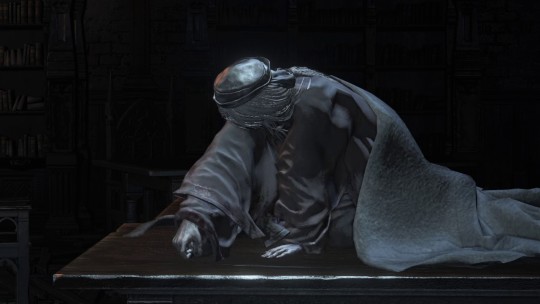
So anyway Gael has yet to realize this. He thinks the Dark Soul is out there in something else. That it will be yielded as a drop if he just kills the right enemy, or 10,000 enemies, or goes to the right place at the right time. You can see that this is something of a synthesis of all the other Buddhist defilements: there are elements of completionism/greed, violence/hatred, mysticism/delusion. There is even the suggestion of the developer of these games again, in that Gael is a “slave,” forced into participation in the world to assist some creative apotheosis. (Isn’t it funny that his weapon is a worn-down executioner’s sword?—whether the person coding or the person playing, we are all “executing” command after command). The thing that really keeps him on the wheel is something beyond any of the player types and their vices; it is almost some sort of pure, amoral automatism, a churning drive that on one side resembles wanton nihilism, and on another side single-minded piousness. Is one disguised as the other, or has Gael somehow stepped beyond this binary? Yet another dichotomy in Dark Souls that begs to be reconciled, but whose tension creates the opportunity to participate creatively in its expansive mythology. When things are held apart we can move between them.
To really understand Gael, we have to contend with the question of a person’s relationship to their own soul, since that relationship is so plainly suggested by Gael and the painter. (This question, by the way, is much elaborated in Elden Ring, with its repeated foregrounding of the image of the maiden or “consort”). If we were to see Gael and the painter as partitions within one person--whether she is his soul, or his inner life, or his better nature, whatever—then in any case Gael is the side which goes out into the world and experiences it. He is the creative extension into the world as its active participant and realizer. Yet he is clothed as the warrior, the executioner. While the one who is dressed as the artist, the painter, just stays in her room and imagines the world—but this is where the magic of creation is really felt. We involve ourselves in life, or in a game, but we are only really changed and renewed when that exterior experience is “brought home” into the inner life. We do something “in the game,” but the act of “painting,” in renewing the world through our creative interpretation, is a decidedly interior experience.
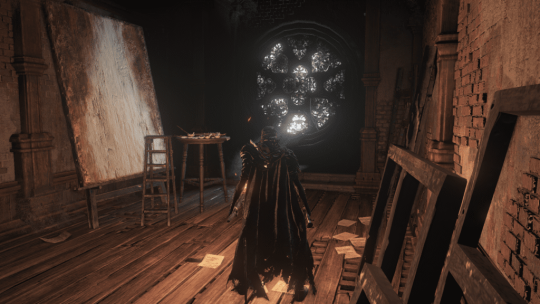
#dark souls#dark souls 3#lords of cinder#game entrainment#dark souls analysis#dark souls lore#ariandel#slave knight gael#the painted world
74 notes
·
View notes
Text
So what's up with the people in dark Souls Souls 3 turning into trees?
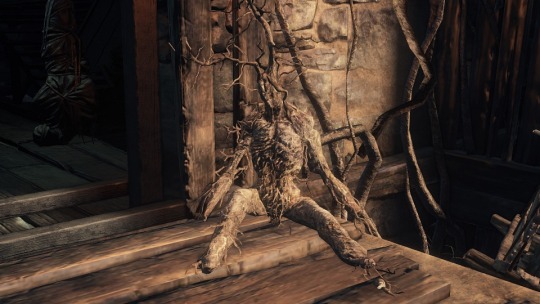
In Dark Souls 3, all around the world, you can find people being transformed into trees. I find this imagery pretty neat for a few reasons: it's completely unique to this game but also it continues the tree motif that the series has. The game also has mysterious pilgrims that long to transform into giant tree-like butterflies. This is never directly explained.
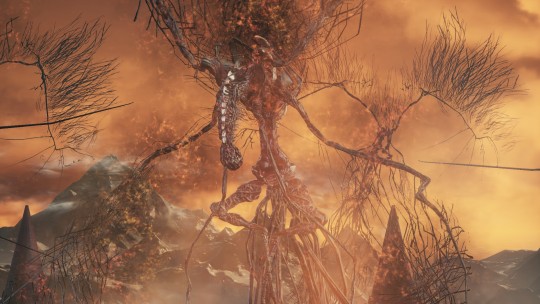
Trees in the dark souls series are the pillars of the world: literally. Before the age of fire the world was composed of nothing but crags, dragons and giant archtrees: after the Lord Souls appeared and were claimed, seemingly a new world (or rather, worlds) was made on top of the archtrees, at least from what we can gather by the ash lake's location.

But of course, there couldn't just be trees, rocks and dragons: a kind of life, after all, rose up to claim the Souls for themselves.
To me, this signifies that the beings that became the gods and humanity were in some way connected to the trees: maybe, in some way, they were trees. And in Dark Souls 3, a world way past its natural end, every living creature is being called back to the way they used to be. Pilgrims hear the calling of the end of the world and set out to ascend their bodies that should no longer belong to them, acquiring their primordial form. And even regular undead can do little to stop the forcible reversing of the state of the world to an age that was already supposed to have come. Eventually, everything will go back to trees.
Or then again, maybe not. After all, even the biggest tree can be burned down to ashes.
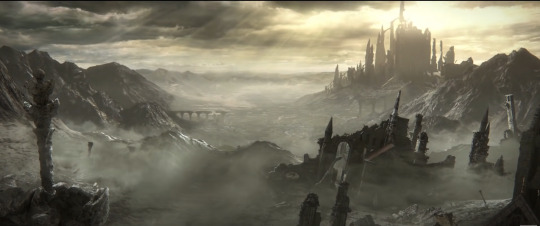
#Dark souls#Dark souls 3#Dark souls lore#soulsborne#Dark souls spoilers#Lore#fromsoft#fromsoftware#nicothoughts
227 notes
·
View notes
Text
youtube
The Old Dragon Slayer is just an asset flip... right?
Oh hey it's Ornstein... question mark. The Old Dragonslayer is found in a crumbling austere cathedral slowly sinking into the sea and he is... literally just Ornstein from Dark Souls 1, at least as a bossfight which is barely remixed for the new game.
And thus it's hard to know whether to... simply consider him fanservice. Or asset recycling. Is there any real meaning to his presence here?
Well you could see it either way, but within the frame of our interpretation that Dark Souls 2 is about identity, there is an interesting question. It looks like Ornstein, it moves like Ornstein, it fights like Ornstein, so... whether or not it actually IS Ornstein inside of there, does that make a difference, from your perspective? Is it enough to merely perform Ornstein to BE Ornstein? If we pantomime the glories of the past hard enough, does that make them real?
These are all interesting questions, and Dark Souls 2 does play a lot with making these references to its predecessor, almost daring you to justify finding them significant. Still, yeah, it's not the same without Smough is it?
My full analysis of The Old Dragonslayer
#tbskyen#dark souls#dark souls 2#fromsoft#from software#soulsborne#dark souls lore#the old dragonslayer#ornstein and smough#Youtube
183 notes
·
View notes
Text
You know i was gonna make sone long ass post comparing Gwyn and Marika but i just realized I dont know jackshit about Marika's plan.
Like we've had 3 games of dunking on Gwyn, telling us how much he fucked up the world and the order of things, both on purpose and by accident.
But Marika???? The shattering must have been at least a bit premeditated, since she was banishing the tarnished a while back, but i could not fucking tell you what her plan is. Why is she doing this? Does she want to free the world from the Greater Will, or does she want to deepen its control? Did she plan for Godwyn to die? What the fuck is Radagon? What even went wrong, since she is crucified inside the erdtree.
Gideon goes fucking insane after having a glimpse of her plan. What the absolute FUCK was this woman cooking???
45 notes
·
View notes
Text
youtube
Bloodborne: Yharnam Sunset
#bloodborne#dark souls#dark souls 2#dark souls 3#dark souls 4#bloodborne 2#demon souls#demon souls 2#hunter's dream#yharnam#yharnam sunset#dark souls rp#bloodborne rp#bloodborne the old hunters#bloodborne art#bloodborne fanart#bloodborne fanfiction#bloodborne good hunter#bloodborne hunter#bloodborne headcanons#bloodborne lore#bloodborne comic#dark souls remastered#dark souls art#dark souls solaire#dark souls fanart#dark souls lore#sekiro#soulsborne#soulslike
8 notes
·
View notes
Text
Hey am i the only one who remembers that in the og description of horace's armor it's stated that him and anri are aldrich's children isnt it a little fucked up that aldrich literally ate his own kids
#and then we find rosaria in the cathedral of the deep with all the cradles surrounding her#going insane rolling on the ground beating my fists against my chest#dark souls 3#horace the hushed#anri of astora#aldrich devourer of gods#dark souls lore#i am. hyperfixating badly on this game lmfaoooo#anyways aldrich is such an interesting lore character he is objectively cool
14 notes
·
View notes
Text
I have the hottest, most unhinged Dark Souls take. You ready for this?
Dark Souls 3 is loosely based on "A Christmas Carol"
May elaborate later.
8 notes
·
View notes
Text
WHAT THE FUCK IS THE AGE OF DEEP SEA?!
Why is that Aldrich’s ENTIRE MOTIVATION and it’s NEVER ELABORATED on further!?
Is it just the age of dark but with an ocean? Or is the fire still lit? Is Aldrich aware of how reality is crumbling? Or does he want to fix it with the power of the gods? WTF
6 notes
·
View notes
Text
Found out I got a new job and I’m starting may 1st (yay), but this also means I have approximately 3 weeks left to finish the dark souls lore research document ai’ve been working on. A ridiculous deadline I’ve set myself for no apparent reason except I don’t want to be doing the ground work for this whilst learning a new job also. Please wish me luck.
2 notes
·
View notes
Text

today's soulsborne fact of the day is: if you REALLY look at the nameless king's model (the screencap is from a hacked copy of the game with some armor layers turned off), somehow, you can see he has a talisman strapped to his chest made from the feathers of his dragon, the king of the storm. this is, probably, how he throws his lightning bolts at you
24 notes
·
View notes
Text

Solaire gay confirmed
2 notes
·
View notes
Text
My favorite bit of Souls lore has got to be the Occult Rebellion from the first one. Cos it’s incredibly significant in the history and ties in to the stories of so many characters we meet and hear about, but it’s also… essentially a conspiracy theory? (About an actual conspiracy, no less!) AFAIK, it’s only actually mentioned in the description of one item, but once you start going down that rabbit hole, there’s so much to discover in the negative space of what you’re told.
3 notes
·
View notes
Text
The primordial serpents of Dark Souls: there is something under the surface

Kingseeker Frampt and Darkstalker Kaathe are two characters that I would define as quite nebulous. Only appearing in person in Dark Souls 1, their presence nonetheless is felt even in future installments. But what exactly is their deal? It's a rather difficult question to answer, for a simple reason: they can't be trusted. At all. This post isn't gonna be a sort of unified theory on who the serpents exactly are: however I'll try to compile most of the information we know and can infer about them and why there's way, way more to them than what meets the eye. Waaaaay more. Yeah this is gonna be a long post. VERY long. But, in my humble opinion, quite thought provoking. Disclaimer: probably not all of the following was intended by the writers. But you know, death of the author and all. I think it's fun to speculate and create meaning even where there might be move.
That said, let's start with the Serpent Species.
Besides Frampt and Kaathe, the Dark Lord ending of Dark Souls 1 (which we'll get back to later) shows us a large number of Primordial Serpents, so we can assume that there's a whole species of them. Maybe. It's never brought up again. Nonetheless, there are several things we can infer about the Serpents in general, or World Snakes as they're known in japanese.
First off, presumably, they're ancient. Duh. How ancient? From the age before the First Flame, possibly. In Dark Souls 3, the description for the Covetous Silver Serpent Ring reads as follows:
A silver ring depicting a snake that could have been, but never was, a dragon.
Interesting. So snakes (or at least some of them) are some sort of imperfect, malformed dragons. Additionally, Dark Souls 3 shows some statues depicting a more humanoid version of the Serpents, of which we can ordinarily only see their heads. Considering their depictions are very different to each other, I'm assuming it's just an artistic interpretation and the sculptors didn't actually know what they looked like. However, one should note the locations of these statues: the Grand Archive (probably connected to Seath's Duke's Archives) and the Ringed City ("gifted" by Gwyn to the Pygmy Lords).
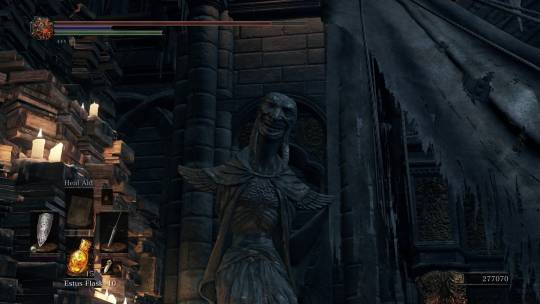

Now, let us talk about Frampt.
That Kingseeker Frampt is lying to you isn't exactly a groundbreaking fact. After all, this close confidant of Gwyn is in cahoots with him regarding the prophecy of a Chosen Undead, a made up folk story to get some poor undead bastard to throw themselves in the fire in order to kindle it once needed. This is all bullshit obviously, there's no such thing as the prophecy and the kindling of the fire is an unnatural sin performed by Gwyn. This means that Frampt is manipulating you with incomplete information in order to get you to link the Flame. One would assume that this would be his ultimate goal.
Or is it?
There are several odd things about Frampt.
For starters, as mentioned before, the Dark Lord Ending. In it, when you refuse to link the fire, Kaathe (we'll talk about him later) makes a point to say that both he and Frampt will now serve you. Why would Frampt do that? You could speculate that he's bound by some sort of oath to the Dark Lord, perhaps because of his nature as a quasi-dragon born in the dark. This could maybe explain the statue of him found in the Ringed City. But by this point, everyone that could be considered his "superior" is dead, and I'm not sure why he would have any obligations to serve you: if he feared being killed by the Dark Lord, well, he could just hide. Perhaps his oath is more fundamental, and he can't go against the Dark Lord because of the very nature of his being. Maybe he allied to Lord Gwyn to try and break this shackle? Perhaps. But I suspect, once again, that there's more to it.
Let's take a look at a very strange mechanic: feeding Frampt.

In Dark Souls 1, you can feed certain items to Frampt, and he'll pay you back with souls. Usually this is not really worth it, because he undervalues items a lot. However, here's the curious thing: for some items, he will only give you a meager 1 soul, while for others he will reward you with a bounty much higher than the value of the item. This is not a mistake, it's hardcoded in, so hey, it should have some significance. Let's look at these outliers.
Frampt will give you 1 soul for anything that has to do with either Seath the Scaleless or Smough; conversely, he will reward you handomely for anything that has to do with Gwyn (soul included), Gwyndolin (soul included), the Moonlight Butterfly, Dragons, Queelag and, funnily enough, women armor sets. So huh, let's unpack this.
It's the women's clothing, believe it or not, that provide some insight. Given that he pays you more for it, I'm assuming that he gives you more souls as a reward for bringing him that item. Either that or he's a misogynist, but I'm more leaning towards horny. And certainly the Soul of Gwyn, the one he pays you the most for, fits: your objective was to kill the crazed Gwyn, and his Soul proves that you've done it. You can't actually feed him it without going to ng+, but hey, it's a technical limitation
With Gwyndolin things start becoming a little bit strange. To have his Soul, you must have killed him. This is a problem for a few reasons: first off, it's his best friend's son. Why would he be happy about you killing him? Secondly, killing him means dispelling the Anor Londo illusion, meaning finding out that the Gods, and him, are lying to you. Now why would he be ok with you knowing that?
The Moonlight Butterfly is a bit strange, since it was created by Seath, but it seems to be connected in some way to Gwyndolin (the moon theming plus the same music). I don't think it's terribly relevant anyway.
Queelag, I have no clue about, epecially considering the fact that he gives no special reward for the Soul of the Witch of Izalith. It could either be because she's guarding the second bell of awakening or because she's hot. Probably cause she's hot.
Now, let's look at a strange thing. He gives nothing for Seath but a lot for the Dragons. Seath betrayed the Dragons, so this is relevant. But how? If he dislikes Seath, this would imply that he's on the dragon's side. But this cannot be, since the dragons and Gwyn are enemies. Maybe he just likes to consume dragon items in an attempt to become a full fledged dragon: this would also be strange considering his allegiance. Maybe he just enjoys eating dragon items but dislikes the taste of Seath (who is physiologically pretty different from other dragons). This, however, would imply that he also enjoyed eating Gwyn and Gwyndolin. Which, frankly, I find the most likely possibility, with interesting implications.
As for Smough, let's be honest, he probably tastes like shit.
Let's move on to Kaathe.

Darkstalker Kaathe seems to be, at the same time, more and less trustworthy than Frampt. More trustworty because he's the one to tell you about the lies of Gwyn, and the truth about the Dark Soul. And he's not lying to you about that. At the same time, he convinced the Lords of New Londo do embrace the Darkness, as well as the people of Oolacile to dig up the corpse of a Pygmy which didn't end very well.
Not much else is known about him: a somewhat obscure fact is that he considers Seath the Scaleless to be a traitor: so, it seems, he's aligned with the dragons despite not being one. What this says about the other Serpent is hard to tell.
However, one last thing is known about him. He wants to let the Flame die, and make the world turn back to an Age of Dark.
Or does he?
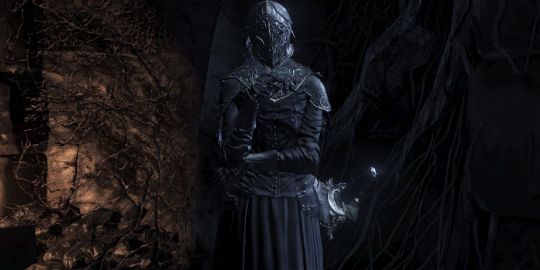
The Sable Church, helmed by Yuria of Londor, is an organization devoted to a single goal: usurp the Flame and bring forth an age not of Light or Dark, but of Hollows. This is different from an Age of Dark in several ways. First off, the Flame persists, but is claimed by an individual who is both Unkindled (that is someone who attempted to link the Flame but failed) and Hollow. In an Age of Dark, with the Flame gone, it is unclear what would happen: it is called many times "the age of humanity", but no one actually knows what humanity's original, primordial form is: for all we know, it could just be an existence spent in a formless void as wandering spirits.
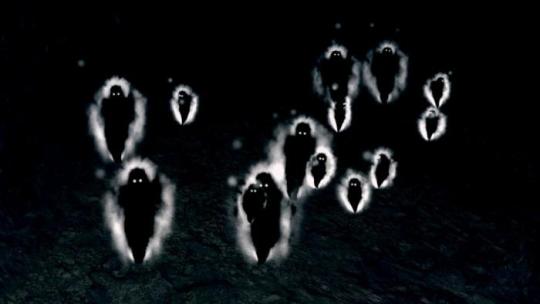
At the same time, nothing says that it couldn't be an utopia: but the point is that you can't know, there is an impassable veil that hides its true nature until it happens. At some point some embers will reappear from the Dark again, and bring forth a new age of Fire. But will it be a good one? Who knows. In comparison usurping the Flame is much more straightforward: similar to the current Age of Fire, except it's Hollows that hold power and not Gods. It is not clear how sentient would Hollows be in such an age, considering their usual zombie-like behavior, but since hollowing is tied to Gwyn linking humanity to the Flame we can presume that something would change, otherwise it would be quite a shitty age and idk why they would pursue it.
There's another thing about the Sable Church. From item descriptions and dialogue it is evident that they worship none other than Darkstalker Kaathe, who appears to have perished since the first game (there's a theory I like about it but this post is already long enough).
Now hold on, hold on. Doesn't Kaathe want to bring forth an Age of Dark? Where did Frampt go in all of this? What is going on?
Let's take a step back. If Kaathe wasn't lying to the Sable Church (and I don't believe he is) then he was lying to you in the first game. Not an unlikely prospect, since Frampt was doing the same thing. But why try and get you to be the Dark Lord if what he was looking for was a Lord of Hollows?
First off let's establish something. No matter which ending you pick in Dark Souls 1, I don't believe that an Age of Dark ever happens between that game and 3. This is because there seems to be a linear continuity (somehwat) between the eras the game is set in, which wouldn't be possible if, well, the cycle underwent a big reset. So even if you become Dark Lord, something happens to stop a true Age of Dark from happening.
With that out of the way, here's what I think. When is the only time that a Lord of Hollows can arise? Only when the world is in shambles due to the strain of the artificial cycle taken to its extreme. How do you get to that point? By continously linking the Flame and making it fight the Abyss over and over, purposefully feeding the feud between Light and Dark that should have already ended long ago, slowly weakening the Flame until it is just barely able to hold on and the entire world has been burned to ashes. At that point the Lords of Cinders arise from their graves to link it again, and again and again, until even them refuse to do it. At this point, the Unkindled will rise: after an endless, purposeful cycle of stirring both the Flame and the Abyss.
Flame and Abyss. Frampt and Kaathe.
I want to show something, now. An interesting little design on an otherwise unremarkable shield. The caduceus round shield.

Two serpents heads, joined at the body. Now, is there any reason to presume that this shield is a true depiction of the nature of Frampt and Kaathe, some sort of bicephalous Ourobouros? Well, we don't know. It would certainly make some amount of sense, however. What I think is that, no matter how literally true this is, it shows at least metaphorically the relationship of the two Serpents. They're working together.
You're not the only undead that they contact, after all. Plenty more people, like you, in your world and parallel ones, are spurred by Frampt to link the Flame and by Kaathe to let it die. This is why neither of them particularly cares about you finding out the truth, or joining the other. You're just a disposable pawn in the grand scheme. When a Dark Lord arise, they pretend to worship them, only to betray them at the last second, getting someone else to kindle the Flame and keep the cycle going. Over, and over again. Till the Unkindled finally rise.
There are, of course, some open questions. Why do they want an age of Hollows to come to pass? Perhaps it is linked to their complicated relationship with dragons: after all, they're only incomplete dragons, and they would hardly have a place in an Age of Dark. Perhaps it has something to do with a promise made to the first Pygmies. Or then again, perhaps to defend against them. And then, what about the other Serpents? Are they working with them? Are they from other worlds? Are they all joined in some sort of giant eldrich hydra, its true body hidden from sight?
It is all very complicated, frankly. We probably will never know the true motives of the Serpents, as well as their nature: however, what I hope this analysis has made clear is that there is much, much more under the surface than what it seems like. Like their body. That's literally under the surface.
#dark souls#dark souls 3#Dark souls lore#Dark souls theory#Soulsborne#Souls series#fromsoftware#fromsoft#Headcanon#fromsoft games#darkstalker kaathe#kingseeker frampt#Kaathe#Frampt#Gwyn#nicothoughts
183 notes
·
View notes
Text
youtube
Dark Souls 2 is a sequel with a better story
Dark Souls 1 was a mythic journey into an ancient fantasy kingdom, it opens with a creation myth / history of the world and casts you in a mythological role - the Chosen Undead, who Prometheus-like must decide the fate of divine fire.
From its opening moments, Dark Souls 2 strikes a different tone. In this game you are a bearer of a curse, a curse which is slowly consuming your mind and eroding you, melting the memories from your mind and turning you hollow. You arrive in Drangleic in ignorance of its history and foreign to it, in the mere hope that here you can find a cure.
Dark Souls 2 is thematically less a journey of discovering your role in the grand weave of destiny, and it isn't even really about the fate of Drangleic or the linking of the fire - it is a relentless confrontation with mortality, with all the ways a person can lose themselves, all the ways you can go hollow.
And this is personal preference, but I think frankly it has a superior and more interesting story than its predecessor. And you can subscribe to follow my series on the bosses of Dark Souls 2 where I will discuss why I feel this way, or you can watch my full-length playthrough and analysis series on my main channel.
107 notes
·
View notes